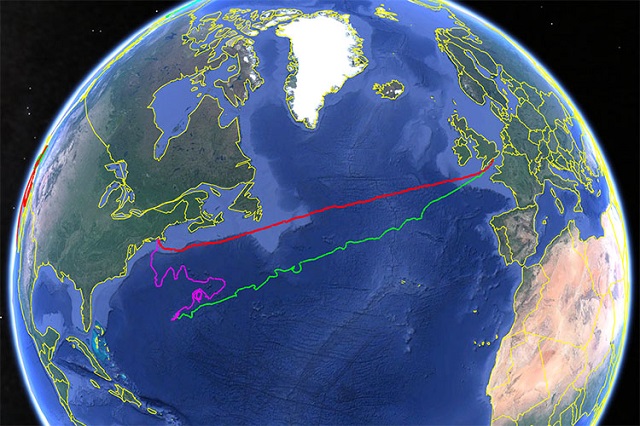Saildrone Makes Another Record Voyage
After setting the record for the fastest unmanned Atlantic crossing, the Saildrone unmanned vessel SD 1021 has now completed the return journey, beating its own record time and also becoming the first autonomous vehicle to transit in both directions across the Atlantic Ocean.
There are two typical trans-Atlantic passages: from west to east, vessels take the northern route from New York to the English Channel, benefiting from prevailing westerlies and favorable current; east to west, vessels take the southern route, from Spain to Bermuda or the Caribbean. Though the southern route is nearly 1,000 nautical miles (1,850 kilometers) longer, crewed vessels enjoy a smoother ride sailing with the trade winds and favorable current.
Saildrone unmanned surface vessels (USVs) are designed to perform in the harshest ocean conditions on the planet, including those that crewed ships often avoid. On its return trip, SD 1021 took the direct northern route, sailing predominantly upwind and against the current, completing the 3,402-nautical mile (6,301.59-kilometer) passage in just 68 days.

SD 1021’s mission track from Newport, RI, to the Gulf Stream (pink), Bermuda to the U.K. (green) and back across the North Atlantic to Newport, RI (red).
The vessels are powered exclusively by the wind for propulsion and use solar energy to run onboard computers and navigational instruments. They are equipped with a suite of science-grade sensors to collect oceanographic and meteorological data above and below the sea surface including wind speed and direction, air and sea surface temperature, atmospheric pressure, photosynthetically available radiation, wave height and period, dissolved oxygen, salinity, and acidity levels. In addition to the standard Saildrone sensor suite, SD 1021 is also equipped with an Acoustic Doppler Current Profiler (ADCP) to measure current strength and direction.
To date, SD 1021 has sailed a total of 14,969 nautical miles (27,722 kilometers) since its first deployment in the Arctic in 2018. The vessel was subsequently deployed from Newport on January 31, 2019, on a 30-day mission to measure wintertime air-sea heat and carbon exchange in the Gulf Stream. SD 1021’s carbon composite wing was damaged in a Gulf Stream storm with winds gusting to 58 knots (107 km/h) and waves over 12 meters (40 feet) high. The vessel’s backup systems allowed it to navigate to Bermuda where it was retrofitted with a new wing and deployed for the Solent.
Saildrone’s fleet of USVs is actively engaged in fisheries, bathymetry, and climate science missions around the globe, with an additional 50 vehicles expected to deploy in 2020.
